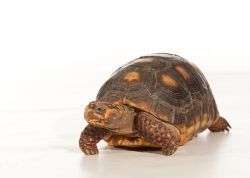Animals retain long-term memory of the biggest and best sources of food

New research shows that red-footed tortoises can remember the location of their favourite food sources and the biggest stashes for at least 18 months.
When animals are making decisions in their environment, it is important that they remember not only the location of key food sources but also where the best or the most food is likely to be. The new findings from researchers at the University of Lincoln, UK, suggest these reptiles have an even greater long-term memory than previously thought.
Earlier studies have shown that animals remember the location of food, but this new research reveals for the first time that they are also able to exercise judgements about quality and quantity and retain this vital information for a long period of time.
The findings are published today (1st February 2017) in the Royal Society journal Biology Letters.
"Long-term memory is an important characteristic for animals which live for a long time, particularly if they inhabit environments where resources are patchily distributed like forests," explained Dr Anna Wilkinson, from the School of Life Sciences at the University of Lincoln. "A long-term memory enables them to retain information that is crucial for survival, such as the appearance and location of key resources.
"Our study shows us that they can in fact remember visual cues associated with different reward values over a period of at least 18 months, demonstrating a significant memory for different quantities and qualities of food. They are able to remember much more than just the presence or absence of food."
Dr Libby John, another author of the study, said: "This is an important distinction to make because, in nature, decisions are rarely clear cut so it is helpful to be able to evaluate the relative benefits of different resources."
As part of the research, red-footed tortoises were trained to associate visual cues (coloured sheets) with specific qualities of food (a preferred mango-flavoured jelly and a less-preferred apple-flavoured jelly) and different quantities. The animals learned which colours were associated with which type and quantity of food, and when they were shown the same cues 18 months later, they remembered their preferences.
The researchers conclude that this long-term memory is likely to impact directly on an animal's foraging decisions. The retention of this information could also improve fitness, as it would make foraging more efficient by eliminating the need to re-evaluate different food sources during each season and reduce the risk of re-visiting inadequate locations.
This new findings suggest that plants which provide better fruit in terms of quality or quantity may receive more visits in a given season, and may also receive repeat visits in successive fruiting seasons. The researchers suggest that this pattern could also have implications for ecological interactions such as herbivory and the dispersal of seeds.
More information: Francesca Soldati et al. Long-term memory of relative reward values, Biology Letters (2017). DOI: 10.1098/rsbl.2016.0853
Journal information: Biology Letters
Provided by University of Lincoln




















